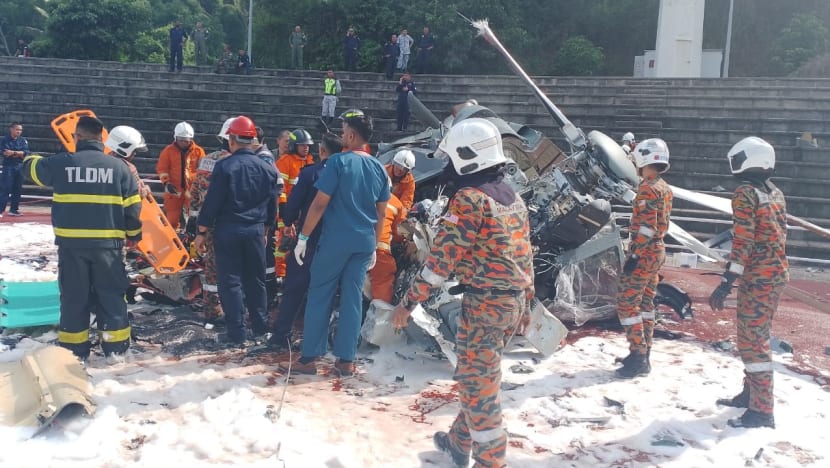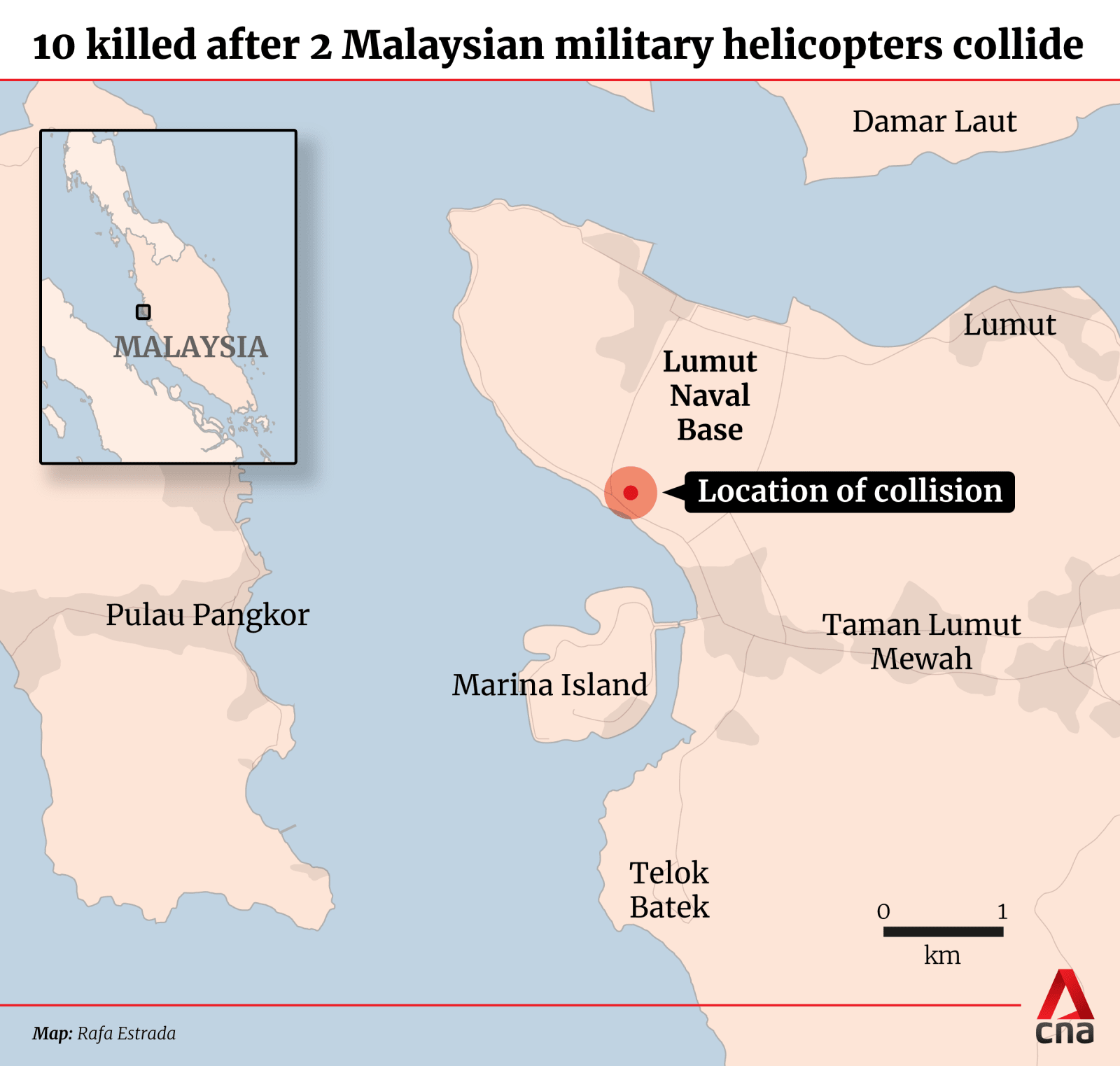Malaysia’s fatal helicopter collision caused by 1 chopper flying at wrong altitude, investigation finds
All 10 crew members who died after their two helicopters collided mid-air on Apr 23 had been deemed fit to fly, investigators say.

The Royal Malaysian Navy said all 10 crew members on board the two helicopters died. (Photo: Malaysia Fire and Rescue Unit)

This audio is generated by an AI tool.
KUALA LUMPUR: The mid-air collision between two Malaysian navy helicopters that killed all 10 crew members on board was caused by one of the choppers flying at the wrong altitude, the navy said in a statement on Thursday (May 30).
“The Fennec helicopter was not at the altitude and direction set for it and had entered the (HOM) AW139’s flight path,” it said.
The Fennec and HOM AW139 helicopters were participating in a parade rehearsal flight with other helicopters over the Lumut Naval Base in Perak on Apr 23.
It was the first time the two had rehearsed together for the 90th Navy Day Parade, CNA previously reported. The parade was later cancelled and a ceremony to pray for the deceased was held instead.

According to footage of the incident, the Fennec collided into the HOM as the pair made a right turn, its main rotor hitting the latter helicopter in a cloud of smoke and flying debris. The helicopters then fell to the ground.
The HOM helicopter crew experienced “channelised attention” when executing the turn, limiting their reaction in avoiding the crash, the Malaysian navy said, identifying this as a secondary factor behind the crash.
The US Air Force has described channelised attention as a tight focus of attention that can lead to the exclusion of comprehensive situational information.
To determine the cause and contributory factors of the crash, a nine-member investigation board comprising Malaysian navy experts in flight and engineering had analysed all flight profiles that day using simulators and actual aircraft.
Beyond that, it found that all crew members were in good health and fit to fly, with valid flight qualifications.
The helicopters involved were also determined to be airworthy, or safe to fly, on the day of the crash, the navy said, adding that the weather that day was “good” and suitable for flight.
The navy’s statement, which described the latest information as the “final report”, did not state any follow-up actions or measures to be taken following the crash.
Prior to the incident, the Fennec helicopter was based in Lumut while the HOM helicopter was based in Kota Kinabalu, Sabah and flew to Lumut to participate in the rehearsals.

NO BLACK BOX ON FENNEC HELICOPTER
The investigation board found that the HOM and Fennec helicopters did not experience any technical issues on the day of the crash.
For the HOM helicopter, this was based on an analysis of its black box, which refers to the flight recorder on planes and helicopters.
This recorder gives important information on parameters like pitch angle, time, speed and power that can give clues about how and why a crash took place.
The Fennec helicopter, on the other hand, was delivered in 2003 and is not equipped with a black box, so its determination was based on documentation as well as “visual and sound analysis”, the navy said.

Investigators had also sought help and advice from Airbus Helicopter, which manufactures the Fennec, on whether the Fennec’s instruments had any data that could help investigations.
But Airbus Helicopter said there were no instruments on board the Fennec with non volatile memory that could help with investigations, the navy said.
“Maintenance work on the two helicopters were found to have been carried out according to procedures and routines determined by the OEM (original equipment manufacturer),” it added.
“Samples of oil, lubricant and diesel were tested and deemed to be normal by the Science and Technology Research Institute for Defence.”
ALL CREW MEMBERS “FIT TO FLY”
Autopsies done on all crew members found that none of them had hypoglycemia - low blood sugar - or elements of fatigue. None of them used banned substances or had recorded or identified mental illnesses, the navy said.
“All crew members involved were deemed medically fit to fly,” it said, adding that the cause of death was “multiple injuries due to aviation crash”.
Nine of the 10 navy personnel were below 40 years old, Malaysia’s Defence Minister Mohamed Khaled Nordin previously said, adding that the youngest was 26 and the oldest was in his 40s.
The navy said on Thursday it has passed on compensation and donations to eligible victims’ next-of-kin, and has started a monthly pension scheme for them.
“The navy welcomes further donations through the Lumut Tragedy 24 fund, which is still open and will continue to be distributed to victims’ next-of-kin,” it said.
“We hope these efforts can help ease the burden faced by victims’ next-of-kin and families.”
















